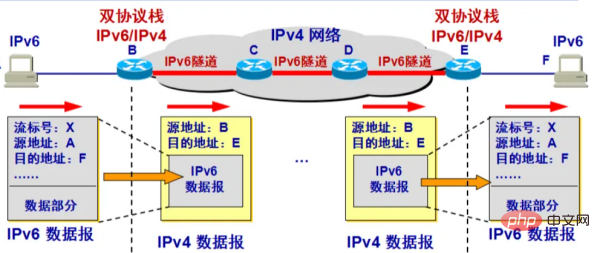What is the core issue of the IP protocol?
The core issue of the IP protocol is routing (path-finding), which means giving the network object an identity so that data can be sent to it in a targeted manner. When an IP data packet is forwarded via a router, if the target network is directly connected to the local router, the data packet is delivered directly to the target host, which is called direct delivery; otherwise, the router looks up the routing information through the routing table and transfers the data packet to Specified next-hop router, this is called indirect delivery.

The operating environment of this tutorial: Windows 7 system, Dell G3 computer.
The core issue of the IP protocol is routing (path finding) , which means giving the network object an identity so that data can be sent to it in a targeted manner.
IP refers to Internet Protocol, the abbreviation of Internet Protocol, which is the network layer protocol in the TCP/IP system. The purpose of designing IP is to improve the scalability of the network: first, to solve Internet problems and realize the interconnection of large-scale and heterogeneous networks; second, to separate the coupling relationship between top-level network applications and underlying network technologies to facilitate the two. Develop independently. According to the end-to-end design principle, IP only provides a connectionless, unreliable, best-effort packet transmission service to the host.

The main content of IP protocol
IP mainly includes three aspects: IP addressing scheme, Packet encapsulation format and packet forwarding rules.
Forwarding rules of IP packets
The router forwards only based on the network address. When an IP data packet is forwarded via a router, if the target network is directly connected to the local router, the data packet is delivered directly to the target host, which is called direct delivery; otherwise, the router looks up the routing information through the routing table and transfers the data packet to Specified next-hop router, this is called indirect delivery.
In indirect delivery, if the router has a route to the target network in the routing table, it will deliver the data packet to the next-hop router specified in the routing table; if there is no route, but there is a default route in the routing table , the packet is delivered to the specified default router; if neither is found, the packet is dropped and an error is reported.
IP Fragmentation
An IP packet may need to pass through multiple different physical networks to be transmitted from the source host to the destination host. Since the data frames of various networks have a maximum transmission unit (MTU) limit, for example, the MTU of an Ethernet frame is 1500; therefore, when the router is forwarding IP packets, if the size of the data packet exceeds the maximum size of the egress link, When transmitting units, the IP packet will be broken down into many fragments that are small enough to be transmitted on the target link. These IP fragments re-encapsulate an IP packet for independent transmission and are reassembled when it reaches the destination host.
IP packet structure
An IP packet consists of header and data. The first 20 bytes of the header are required by all IP packets and are also called fixed headers. Following the fixed part of the header are some optional fields, the length of which is variable.
For more related knowledge, please visit the FAQ column!
The above is the detailed content of What is the core issue of the IP protocol?. For more information, please follow other related articles on the PHP Chinese website!

Hot AI Tools

Undresser.AI Undress
AI-powered app for creating realistic nude photos

AI Clothes Remover
Online AI tool for removing clothes from photos.

Undress AI Tool
Undress images for free

Clothoff.io
AI clothes remover

AI Hentai Generator
Generate AI Hentai for free.

Hot Article

Hot Tools

Notepad++7.3.1
Easy-to-use and free code editor

SublimeText3 Chinese version
Chinese version, very easy to use

Zend Studio 13.0.1
Powerful PHP integrated development environment

Dreamweaver CS6
Visual web development tools

SublimeText3 Mac version
God-level code editing software (SublimeText3)

Hot Topics
 1384
1384
 52
52


